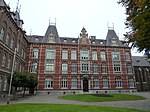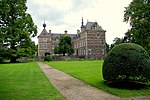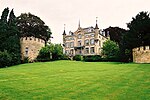Eijsden-Margraten

Eijsden-Margraten (Dutch pronunciation: [ˌɛizdəˈmɑrɣraːtə(n)]; (Limburgish: Èèsjde-Mergraote) is a municipality situated in the very south of the Netherlands. There it is located in the southeastern part of the province of Limburg. This municipality was formed in 2011 from the former municipalities of Eijsden and Margraten, that both consisted of a number of separately situated villages. As a result, the nowadays Eijsden-Margraten municipality consists of 28 villages and townships, spread out over 15 administrative centres. As of 2011, it has a population of about 25,000. Eijsden-Margraten is one of the most southerly municipalities in the Netherlands, for in its south it is extending up to the most southerly part of the border between the Netherlands and Belgium. The Meuse river, coming from France and Belgium, at Eijsden enters its third and final flowing country, the Netherlands. From here on its name in Dutch is "Maas". Running northward to Eijsden-Margraten's west it locally forms the westerly frontier of the last mentioned country with Belgium. A smaller stream, the Voer, coming from Belgium, drains into the Meuse river in this municipality, after having passed through a few of its villages.
Excerpt from the Wikipedia article Eijsden-Margraten (License: CC BY-SA 3.0, Authors, Images).Eijsden-Margraten
Trichterweg, Eijsden-Margraten
Geographical coordinates (GPS) Address Website Nearby Places Show on map
Geographical coordinates (GPS)
| Latitude | Longitude |
|---|---|
| N 50.783333333333 ° | E 5.7 ° |
Address
Watersportvereniging Eijsden
Trichterweg
6245 GK Eijsden-Margraten
Limburg, Netherlands
Open on Google Maps










